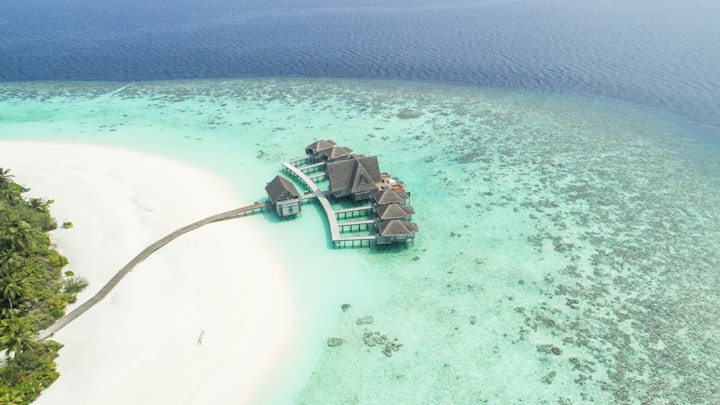
The 1192 island archipelago nation of Maldives is one of the most beautiful tropical destinations on planet Earth from its warm, clear waters to its rich diversity of life thriving in said waters. Unfortunately, with global warming’s exponential acceleration and with sea level on the rise year after year, the nation of Maldives is legitimately soon approaching total submergence as time marches forward. Despite the ruinous odds, the people of Maldives continue to remain vigilant through proactive and progressive measures to help prevent utter desolation and rise above the impending obstacles they yet to face; a prudent question however remains, are their efforts supremely impactful or utterly fruitless?
Maldives Topography:
Amongst all other nations of the world, the Maldives stands as the flattest country of them all, with roughly 80% of all 1192 island constituents being under 1m above sea level [1]. Being as flat as it is, the Maldives are left quite vulnerable to the impending wake that meets the nation and its people on all sides. This is entirely on account of the archipelago nation consisting completely of coral islands that make up the nation of Maldives.

The nation of Maldives coral island foundation had taken millions upon millions of years to fully develop to the entire archipelago seen to date. All islands formed from a foundation of coral detritus as well as other associated carbonate and ocean sediment components. Coral Islands begin as volcanic islands underneath hot spots; with fringing reefs growing along the outskirt of the mass, the volcano moves off center of the hot spot in accordance with plate tectonic shifts, no longer being capable of withstanding wave erosion and eventually collapses undergoing subsidence [2]. With the island submerged, coral continues to grow and forms a lagoon in the center. Here, accretion, or the process of additional carbonate material buildup atop a tectonic plate, makes up the organic foundation of coral islands [2]. These coral island foundations are the main contributor to the low-lying nature of the republic and are additionally why the nation is incredibly susceptible to wave erosion as well as impending sea level rise through time.
Figure 2: An animation detailing the dynamic formation of a coral island, potentially taking as long as 30,000,000 year to finalize (How a coral atoll forms: Corals Tutorial (noaa.gov))
When considering the Maldives’s overall topography into question, the incredibly low-lying nature of the entire nation and the anticipated rise in sea levels year after year due to the ongoing exponential effects of global warming leave the nation very susceptible towards imminent thermal expansion of the ocean over the course of this century. The projected sea level rise of 0.3-2.5m by 2100 leaves Maldives very vulnerable to marine transgression in the form of severe flooding incidents and prevalent coastal erosion due to global warming [3]. Maldives is in a potential range to lose approximately 80% of its land by 2100, losing countless homes in displacing an estimated 250,000 individuals and integral infrastructures [3].


2004 Indian Ocean Tsunami:
To truly illustrate Maldives’s vulnerability to ever rising sea level, the Indian Ocean Tsunami occurring in 2004 lends itself well as a case study to further illustrate the dire straits the nation finds itself in. In 2004, a massive 9.2 earthquake shook the country of Sumatra, enacting a tsunami to ravage Maldives and all neighboring countries surrounding the Indian Ocean. Although Maldives had not received the brunt of this disaster, the country did suffer 39 of 200 inhabited islands significantly ravaged and the displacement of over 20,000 people, not to mention experiencing the deaths of 88 individuals and the loss of 24 others (presumed dead) [4]. Taking into consideration the significant overall impact despite being roughly 2,000 miles away from the epicenter, Maldives took a serious hit overall from this disaster. When compared to a country like Malaysia, much closer in proximity to the epicenter, the damage dealt was on par if not lessened due being significantly higher above sea level compared to Maldives, further highlighting Maldives’s susceptibility as a direct result of its natural topography. Such examples like this explicitly indicate how much at risk the Maldives truly are to sea level rise and immediate action is clearly necessary for the Maldivian people’s sanctity.

Underwater Cabinet Briefing:
After the devastation that rocked the Maldives in 2004, the nation required swift and effective action to ameliorate not only the resulting damage but also the damage soon to come that could not be undone. In 2009, an event transpired that sparked a moment of clarity wherein the president of the time, Mohamed Nasheed, and his associated cabinet members ingeniously took a dive into their nation’s waters and held a conference to discuss the impact of climate change towards Maldives. Although seemingly a mere publicity stunt to attract the attention of individuals all around the world of their endeavors, this cabinet meeting still stood firmly to tackle the issues surrounding climate change mitigation action and the dangers of global warming impending for Maldives [5]. The Maldivian government partnered with the UN Intergovernmental Panel on Climate Change to help get the country on track to mitigate ramifications of global warming impacting the republic, focusing intently on reducing greenhouse gas emissions to any reasonable extent [5]. This conference successfully garnered the attention of Maldives’s genuine endeavors to strive for change, really illustrating Nasheed’s desire to set his nation on the right path despite the unfavorable odds. However, these ambitions would prove to be rather difficult to fulfill as the tourism and fishery services of Maldives hugely contribute to their economy as the nation’s primary and secondary sources of commerce respectively but also huge contributors towards increasing greenhouse gas concentrations in our atmosphere.

Tourism is the number one source of revenue for the people of Maldives, contributing approximately to 28% of the GDP [6]. With copious amounts of CO2 emissions deriving from airplane contrails, the nation of Maldives is between a rock and a hard place in their efforts to reduce greenhouse gas emissions when in need of the flooding on tourists [6]. Efforts have been made to limit the travel of Maldivian civilians by way of airplanes but remain unsubstantial with tourism growing ever more popular. Fishing is the second most integral activity influencing the economy in the Maldives, contributing approximately to 15% of the GDP [6]. The collecting and exporting of fish by way of these diesel-powered boats has the added consequence of additional CO2 concentrations to our atmosphere through their travels [6]. Efforts have been made toward sustainable technology enhancements, but such projects require absurd investments and in some cases are still in the works. Any major meddling performed in either industry could potentially spell drastic consequences for the Maldivian economy, making it rather difficult to comply with climate conscious demands.
The possibility of complete relocation for the entire population has been considered when all other options appear in vain. Nations such as India, Sri Lanka, and Australia have settled on offering portions of land for the occupation of eventual refugees [7]. Because of the nature of this plan of action, it is unclear how much the quality of life for these people will shift with the move, taking into consideration their financial situation as well as their personal traditions retained. Construction of new artificial islands for migration has also begun through the process of sand dredging from the ocean depths, land masses planned up to 5m in height as another solution for relocation [7]. However, with the continued rise in sea level in tandem with the structural integrity in question makes this project seem futile. Although total migration is to be considered a “last-ditch effort”, it appears that it may in fact be the most appropriate option in accordance with the thermal expansion of the ocean annually.
Current Progress:
As it stands to date, Maldives produces approximately 1,240,000 tons of CO2 emissions annually, an average of 2.60 tons per capita, and ranks 127th with an EPI, or Environmental Performance Index, score of 35.6 out of 100 when compared on a global scale [8]. To put this in perspective, CO2 emissions stood at approximately 680,000 tons annually with an average of 1.93 tons per capita at the time of the conference, so their CO2 contributions have only increased from a little more than a decade back [8]. This can be attributed to the population doubling ever since as well as the generally unsubstantial compromises that have been established to mitigate said issues. Moreover, Maldives had originally planned to be Carbon neutral through the elimination of all greenhouse gas emissions within the country by 2020 but unfortunately have yet to come close to reaching that desired standard, now pledging for 2030 instead [8].
Conclusion:
The Maldives currently stands as a country in desperate need of immediate action with regards to the continuous rise of sea level potentially leaving the nation completely under water in due time. Incorporation of more sustainable technology would need to come into play when considering the nation’s over reliance on fossil fuels to thrive economically just making matters worse but in the grand scheme of things [8]. While preparing for the inevitable, the people of the Maldives still maintain making a conscious effort to albeit the unpleasant circumstances awaiting the nation that only time will tell.
References
1. Tariq Masood Ali Khan, Dewan Abdul Quadir, T. S. Murty, Anwarul Kabir, Fahmida Aktar & Majajul Alam Sarker. Relative Sea Level Changes in Maldives and Vulnerability of Land Due to Abnormal Coastal Inundation. Marine Geodesy. 2010 Nov 10. DOI: 10.1080
2. Amy Tikkanen, John Rafferty. Coral Island. Britannica Encyclopedia. 2012 Nov 1. DOI: 10.1020
3. Alex Arnall, Uma Kothari. Challenging Climate Change and Migration Discourse: Different Understandings of Timescale and Temporality in the Maldives. ScienceDirect. 2015 Jan 11. DOI: 10.1016
4. Ali M., Kan H., Riyaz M. The 2004 Indian Ocean Tsunami in Maldives: Waves and Disaster Affected by Shape of Coral Reefs and Islands. ADS. 2015 Dec 21. DOI: 10.1081
5. Eric Hirsch. “It won't be any good to have democracy if we don’t have a country”: Climate change and the politics of synecdoche in the Maldives. ScienceDirect. 2015 Sep 8. DOI: 10.1037
6. Erica Techera, Madelaine Cannell-lunn. A Review of Environmental Law in Maldives with Respect to Conservation, Biodiversity, Fisheries and Tourism. Asia Pacific Journal of Environmental Law. 2019 Nov 19. DOI: 10.1019
7. Robert Stonjanoz, Barbora Duzi, Ilan Kelman, Daniel Nemec, David Porchazka. Local Perceptions of Climate Change Impacts and Migration Patterns in Maldives. The Geographical Journal. 2016 Jul 7. DOI: 10.1111
8. Klaas van Alphan, Wilfried van Sark, Marko Hekkert. Renewable Energy Technology in the Maldives-Determining the Potential. ScienceDirect. 2016 April 3. DOI: 10.1015






Comments
There are no comments for this story
Be the first to respond and start the conversation.